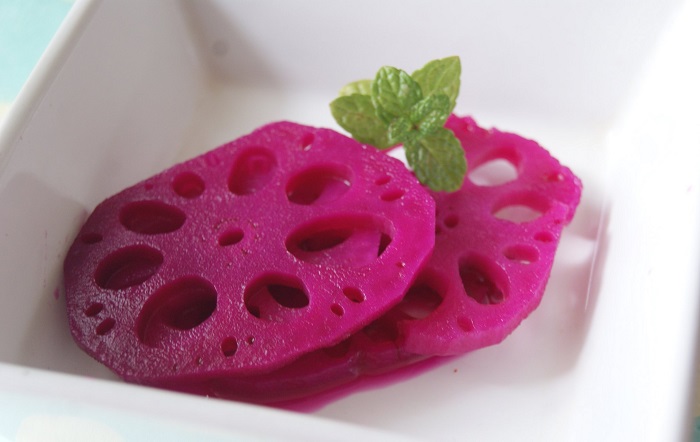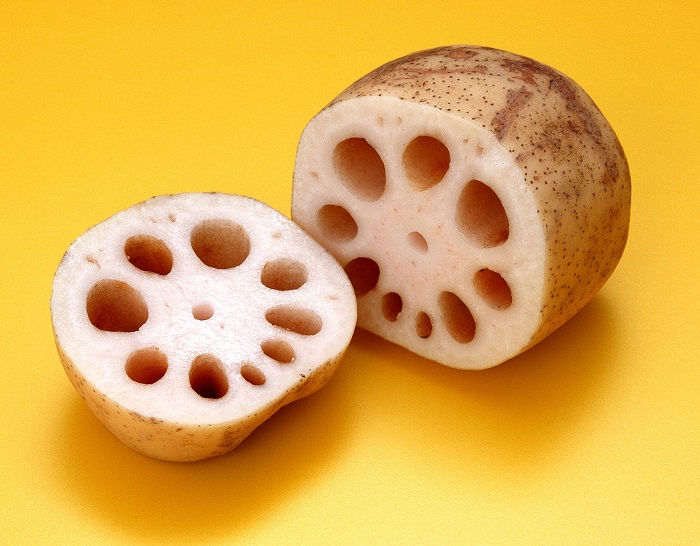Main Name: Lotus Root
Biological Name: Nelumbo nucifera
Names in other languages: Kamal Kakri, Bhen (Hindi), Thamari Kizhangu (Tamil), Tamara Kizhangu (Malayalam), Tamaradumpa (Telugu), Surya kamal (Gujarati), Kamala Mudh (Bengali), Kamala (Marathi), Padam (Oriya), Kanwal Kakri (Urdu), Kamal Kakri (Punjabi)
Biological Name: Nelumbo nucifera
Names in other languages: Kamal Kakri, Bhen (Hindi), Thamari Kizhangu (Tamil), Tamara Kizhangu (Malayalam), Tamaradumpa (Telugu), Surya kamal (Gujarati), Kamala Mudh (Bengali), Kamala (Marathi), Padam (Oriya), Kanwal Kakri (Urdu), Kamal Kakri (Punjabi)
What do you associate the word ‘lotus’ with, when it comes to your mind? A car, a flower, or food? Believe it or not, there are lotus cars, lotus flowers, and even lotus delicacies. Yes, people consume lotus roots that are derived from lotus flowers. Now, you must be familiar with the sacred and most celebrated flowering plant called lotus, which is found in South Asia. Also known as the sacred lotus, Indian lotus, and Chinese water lily, lotus plant is the only known plant to thrive in all three elements simultaneously – earth, water and air. While the plant displays the beautiful flowers, seed heads, and wide leaves above the water surface, what lies beneath the water is the root portion, known as lotus root or rhizome. A look at the outside of the lotus root does not seem appealing, but once the ends are cut and the outer skin is peeled, you will find the creamy-white flesh beneath with cylinder holes running from one end to the other, appearing like mini tunnels or airways. With a slight crisp, a little crunchy texture, and not a very strong flavor, lotus root blends well in many recipes. Coming to the nutritional front, lotus root is enriched with various nutrients necessary for a healthy life. Read further as we acknowledge you with some secret healthful benefits that lotus roots provide.
History
The lotus root has a history of three to five thousand years in Southeast Asia. Though the leaves and seeds were in use, the roots were more common, particularly in Chinese cookery. Moreover, the lotus flower played special significance for Buddhists and was regarded as a divine symbol of purity, representing sexual purity, a virtue. As per Buddhist iconography, Lord Buddha was depicted holding or sitting on a pink lotus. How the lotus root was introduced in America is uncertain, but it is highly valued by Native Americans, especially the wild American lotus, also known as water, chinquapin or duck acorn. But the lotus root that is sold across the globe is the Asian variety, generally imported from China and India. Health Benefits of Lotus Root
Health Benefits of Lotus Root
The lotus root has a history of three to five thousand years in Southeast Asia. Though the leaves and seeds were in use, the roots were more common, particularly in Chinese cookery. Moreover, the lotus flower played special significance for Buddhists and was regarded as a divine symbol of purity, representing sexual purity, a virtue. As per Buddhist iconography, Lord Buddha was depicted holding or sitting on a pink lotus. How the lotus root was introduced in America is uncertain, but it is highly valued by Native Americans, especially the wild American lotus, also known as water, chinquapin or duck acorn. But the lotus root that is sold across the globe is the Asian variety, generally imported from China and India.
 Health Benefits of Lotus Root
Health Benefits of Lotus Root- The presence of vitamin C in large amounts in lotus root is known for benefiting the body in numerous ways. It aids in improving wound healing, enhancing the immune system, preventing cells from damage, reducing aging, lowering the risk of certain cancers, and stimulating lung functioning and iron absorption. Besides, it is highly useful for promoting the health of gums and teeth.
- Potassium is essential for the proper functioning of nerves and muscles. Lotus root contains this mineral in abundance which assists in the reduction of confusion, irritability, and fatigue, apart from lowering the chances of heart problems and high blood pressure.
- Rich in dietary fiber, lotus root is important for regulating blood sugar levels and cholesterol levels. To add on, lotus root prevents constipation and hemorrhoids, apart from promoting weight loss.
- Drinking 2-3 glasses of juice extracted from lotus root helps in stopping bleeding in esophagus and stomach (vomiting blood); bleeding of the rectum, intestines and stomach (blood in feces); and nose bleeding or gum bleeding.
- Juice extracted from raw, finely grated lotus root is highly recommended for treating lung-related ailments, such as tuberculosis, asthma, and coughing. It also helps in reducing the risk of heart disease, by increasing energy and neutralizing toxins.
- Lotus root tea is very effective in bringing relief to coughing by melting the mucus accumulation in the body, particularly in the respiratory system.
- Lotus root juice, when mixed with juice of grated ginger, is said to be useful for curing enteritis, or the inflammation of the intestine.
- A plaster, made from lotus root, white flour, and grated ginger, when applied to the face, helps in alleviating facial inflammation and congested sinus cavities.
- A macrobiotic remedy is prepared by combining lotus root and kuzu which is often ingested for curing colds, accompanied by fever and/or troubled stomach and intestines.

http://en.rocketnews24.com/2014/03/19/lotus-root-the-enlightened-way-to-knock-out-hay-fever/
Lotus Root Nutrition FactsAmount: 1 cup
Total Weight: 120 g
Total Weight: 120 g
| Nutrients | Amount |
| Basic Components | |
| Proteins | 1.9 g |
| Water | 97.7 g |
| Ash | 1.2 g |
| Calories | |
| Total Calories | 79 |
| Calories From Carbohydrate | 74 |
| Calories From Fat | 0.7 |
| Calories From Protein | 5.3 |
| Carbohydrates | |
| Total Carbohydrates | 19 g |
| Dietary Fiber | 3.7 g |
| Sugar | 600 mg |
| Fats & Fatty Acids | |
| Total Fat | 84 mg |
| Saturated Fat | 25 mg |
| Monounsaturated Fat | 17 mg |
| Polyunsaturated Fat | 17 mg |
| Omega-3 Fatty Acids | 4.8 mg |
| Omega-6 Fatty Acids | 12 mg |
| Vitamins | |
| Vitamin C | 33 mg |
| Vitamin E | 12 mcg |
| Vitamin K | 0.12 mcg |
| Thiamin | 152 mcg |
| Riboflavin | 12 mcg |
| Niacin | 360 mcg |
| Vitamin B6 | 262 mcg |
| Folate | 9.6 mcg |
| Pantothenic Acid | 362 mcg |
| Choline | 30.5 mg |
| Minerals | |
| Calcium | 31 mg |
| Iron | 1.1 mg |
| Magnesium | 26 mg |
| Phosphorus | 94 mg |
| Potassium | 436 mg |
| Sodium | 196 mg |
| Zinc | 396 mcg |
| Copper | 260 mcg |
| Manganese | 264 mcg |
| Selenium | 0.72 mcg |
How many calories in lotus root (per 100 gm)
Lotus root has about 66 calories per 100 gm of weight.
Lotus root has about 66 calories per 100 gm of weight.
How to Buy Lotus Root
- While purchasing lotus root, always look for ones that are firm, plump, juicy and pinkish or grayish in color. Make sure that they are smooth and free from blemishes and soft spots.
- Avoid selecting lotus root with dark or soft spots. If allowed, ask the helper to cut a lotus root to check its channels. In case the channels are ringed with a dark brown or black lining, it is an indication of an aged lotus root.
 https://www.1stdibs.com/jewelry/bracelets/cuff-bracelets/tiffany-co-lotus-root-jade-gold-cuff-angela-cummings/id-j_202602/
https://www.1stdibs.com/jewelry/bracelets/cuff-bracelets/tiffany-co-lotus-root-jade-gold-cuff-angela-cummings/id-j_202602/Lotus Root Storage Tips
- Wash and scrub the whole lotus root once you’ve purchased it. Cut off the ends about ¼ inch from the segment joints.
- Whole lotus root can be stored in a sealed plastic bag with water in the refrigerator for two to three weeks. For maximum taste and flavor, prepare the lotus root within a week of purchase.
- As for storing cut lotus root, cover it with lemon juice and cold water, and place in the refrigerator where it will keep fresh for up to 5 days.

